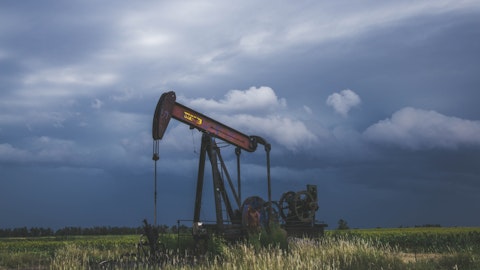Tristan Richardson: Yes. Appreciate it, Diaco. And then, maybe, Robert, I know it’s too early to talk about 2024 CapEx guidance, but just thinking about the deployments you made this year in the Rough Rider expansion in the City of Williston. And then thinking about well completions in the second half. Is there a scenario where we could see CapEx lower in 2024 versus 2023 and increase the free cash flow production?
Johnny Black: Yes. Tris, and I’ll take that this question. This is Johnny. It’s a great question. I think the short answer to your question is yes, absolutely. Right now, the midpoint for our ’23 CapEx program is roughly $145 million of growth capital for this year. At this point, based on the substantial amount of well connect next year, we are still expecting that number to decline pretty substantially in 2024, by roughly 25% to 30%, year-over-year. So I’d call it between $100 million to $110 million of CapEx in 2024. And that will primarily be focused around well connect capital and gathering expansions to meet the capacity needs of our customers in the areas where they are developing. So, you call it, growing EBITDA and reduced CapEx should meaningfully boost our free cash flow profile next year.
Operator: Next question comes from Neal Dingmann with Truist Securities. Please go ahead.
Neal Dingmann: Good morning. Maybe Johnny my first question for you specifically on leverage. I think you all said last quarter, you’ve talked about your leverage target moving from around 3.5 to under 3.5. So I’m just wondering, does this mean, you all will plan to get closer, much closer to the 3x level? Before you think about any allocated any incremental returns? Or maybe just talk about, paying off the returns versus the debt repayment?
Johnny Black: Yes. Hey, Neal, this is Johnny, I’ll take that one as well. As you called it, we’ve been very focused on the balance sheet, and allocating all excess free cash flow to debt paid down. I think we want to get our leverage down closer to 3.5x before we start thinking about incremental returns to unitholders. I’d say, it doesn’t have to be closer to 3x, I think we want to be at 3,5x on a run rate basis. And I think that’s the best use of capital at this point in time, as we get into 2024, I’d say allocation of capital will really be a function of the outlook for the business at that point in time, and opportunities to reduce our cost of capital and continue to drive value for our investors. The Crestwood Niobrara asset level preferred will be high on our list to redeem, especially given the holders have redemption rights that kick in 2024.
And we would like to utilize some amount of balance sheet capacity to start taking out a piece of that security and reducing our cost of capital next year.
Neal Dingmann: Yes, that definitely makes sense. And then maybe just the second one I have is on commodity sensitivity. Specifically, I think it’s about what you’ve said in the past about 15% of cash flows, correlate the commodity prices, with more sensitivity in the Bakken versus the [indiscernible]. And just wondering, is this still the case around those levels? And is there any plans to try to mitigate that? Are you fine with kind of those levels as they sit today?
Johnny Black: Yes. Again, Neal, great question. And this is Johnny. You’re spot on, roughly 15% of our company cashflow directly tied to commodity prices be our POP contracts in the Williston and Delaware, I’d say roughly 75% of that is in the Williston, roughly 25% of that is in the Delaware. The rough breakdown by commodity is roughly 40% natural gas, 40% natural gas liquids and 20% crude oil. So as you can see, based on those percentages, we have a meaningful amount of margin for both natural gas and NGLs, which is where we saw the most amount of the price degradation in the second quarter. As Bob mentioned in his comments, we’ve already seen a nice uptick here in commodity prices from the lows of Q2 and expect further uplift between now and the end of the year based on current strip prices.



